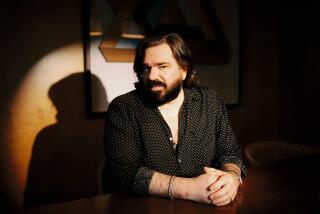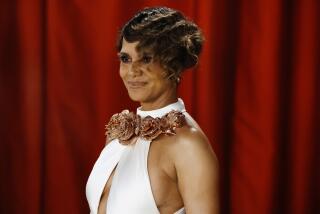MOVIE REVIEWS : THE WORLDS OF BERRY, BALLET : Star and His Music Are Hale ‘n’ Hearty in ‘Hail! Hail!’
- Share via
When Chuck Berry is on stage for his 60th-birthday concert in “Chuck Berry: Hail! Hail! Rock ‘N’ Roll!” (opening Friday, selected theaters) his eyes sometimes get a contradictory glow: dark and devilish on top, impish underneath. They mock that old canard that rock ‘n’ roll is Satan’s tool.
Hell’s clammy clasp isn’t in evidence here. The music and the movie pound with life’s beat, passion’s pulse. “Hail! Hail! Rock ‘N’ Roll!” is one of the saltiest, most stirring rock documents ever: a terrific show and a real labor of love by director Taylor Hackford. Cinematographer Oliver Stapleton (“Absolute Beginners”) lights a fire under the images; Hackford fans the flames, and Berry, aided by Etta James, Robert Cray, Eric Clapton, Linda Ronstadt, Julian Lennon and others, lays out a scorching birthday set.
Drenched with sweat, the show’s star often looks outrageously youthful, untouched by travel, travail, sex or excess. He goes like 60, spinning out, as he has for decades, his melodic anecdotes of life as a teen-ager: of love and sex, fast cars, school and work, the toils of finance and romance. It’s often argued that writer-composer Berry never developed far enough afterward, but these early songs pack the same immediacy they did 30 years ago. They’re full of fast-tongued wit, lyrical alliteration and twisting rhyme schemes: these anthems to “Memphis,” “Maybellene,” “Nadine” and “Sweet Little Sixteen” and that inspiring tale of “Johnny B. Goode,” the “country boy”--”colored” in Berry’s original lyric--who triumphantly heeded his mother’s exhortations to “Go, Johnny, go!”
Berry’s band here is gloriously catholic, ranging from lead guitarist and music producer Keith Richards to soulful, roly-poly pianist Johnnie Johnson, barrelhouse boogie expert and part of the original Berry trio. One of the backup singers is daughter Ingrid Berry. But though the band slashes across cultures and countries, there are clashes too. The skeletally laconic and jaded-looking Richards, often considered Berry’s main disciple on guitar, argues quietly with Berry during rehearsals, grins hopelessly when the star switches keys in the middle of the opener, and finally declares his lifelong exemplar “a bigger headache than Mick Jagger.” There’s affection and respect underneath; the jibe doesn’t sting.
It’s a great concert, but it’s also a fascinating character study. Hackford--an ex-TV documentarian and longtime rock aficionado--seems to be taking his cue here from Martin Scorsese’s film on the Band, “The Last Waltz,” though from a slightly tougher, less poetic viewpoint. The earlier movie’s star, Robbie Robertson, is listed here as a creative consultant. As in “Waltz,” Hackford intercuts the songs with interviews--including one touching Berry monologue in the towering, baroque Fox Theater in St. Louis: the concert site here, and once off limits to blacks.
We hear friends and family, Berry’s longtime secretary Francine Gillium and fellow ‘50s rockers like “The Killer” Jerry Lee Lewis (recalling the time Chuck “whupped” him), Little Richard (exploding ecstatically, with epicene effusiveness), Bo Diddley (manful and soulful) and Roy Orbison (mournful and philosophic). There’s also a long, funny reminiscence by the now better-known leader of one of Berry’s numerous roadshow backup bands back in the ‘70s: a singer-guitarist erroneously advertised for that gig as “Bruce Spring stein .”
Hackford shows Berry from several angles: as stubborn and philosophical, outlaw and family man, devil and angel, dutiful and prodigal son, rebel and traditionalist. This presumed despoiler of the ‘40s big band traditions confesses himself a disciple of swing era guitarists Charlie Christian and Carl Hogan. This self-admitted sexual adventurer--rock’s seminal figure in several senses--is fanatically protective of his family.
But the flip side of “Johnny B. Goode,” Berry’s “bad” side--his three famous brushes with the law: for a teen-age robbery, violation of the Mann Act and nonpayment of taxes--goes unexplored here. When the incidents are brought up, he simply snaps that the time is inappropriate for discussion--using the same brusque finality to switch off an interview with his wife of nearly 40 years, Themetta. The appropriate time never comes. For those revelations, you have to read Berry’s recent, highly entertaining “Chuck Berry: The Autobiography.”
The film, instead, catches him at the fiery peak of his concert, scuttles over those dark lows and leaves him in a gentle mood, playing sweetly piercing guitar to the ballad “Cottage for Sale” in the shadowy quiet of his fancy home.
In the end, “Hail! Hail!” (MPAA-rated: PG) celebrates rock and Berry’s role in it as parts of a great, populist strain: a unifying, integrating music whose streams flowed from rhythm and blues, gospel and the country-and-Western which fed straight into Berry’s first hit, “Maybellene.” They all come together here, on a stage and theater packed with the old and the young, black and white, joined in the unity that life rarely offers but that art and music sometimes touch. There are a lot of cautionary notes in Berry’s life-tale: warnings about sudden success, shortcuts and the chains of racism, grim reminders of the intertwisting links between sex, success and money--but the music finally triumphs. And, as the star has already warned us: “It’s gotta be rock ‘n’ roll music, if you wanna dance with me!”
More to Read
Only good movies
Get the Indie Focus newsletter, Mark Olsen's weekly guide to the world of cinema.
You may occasionally receive promotional content from the Los Angeles Times.










